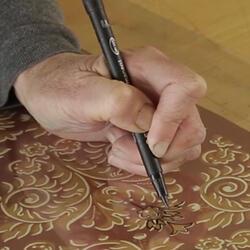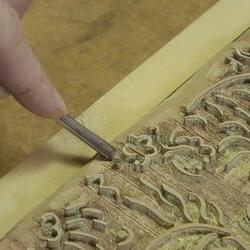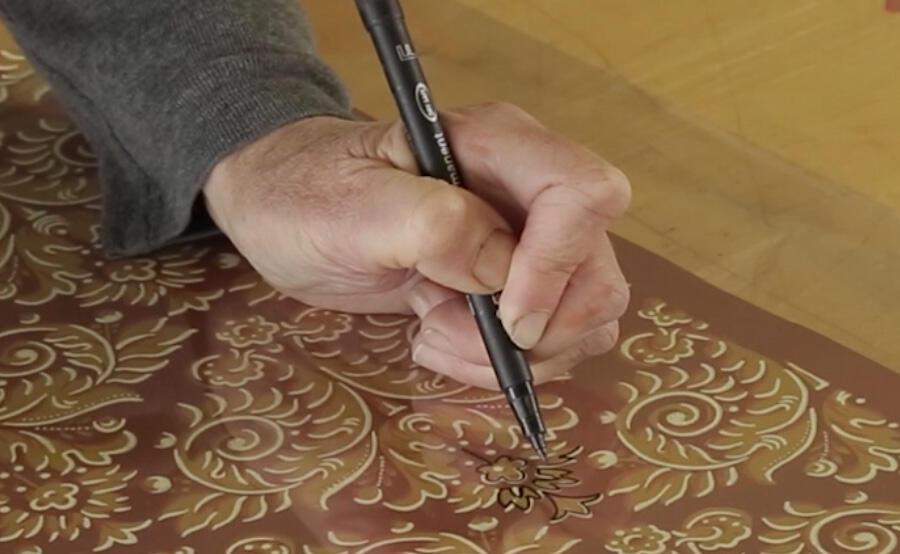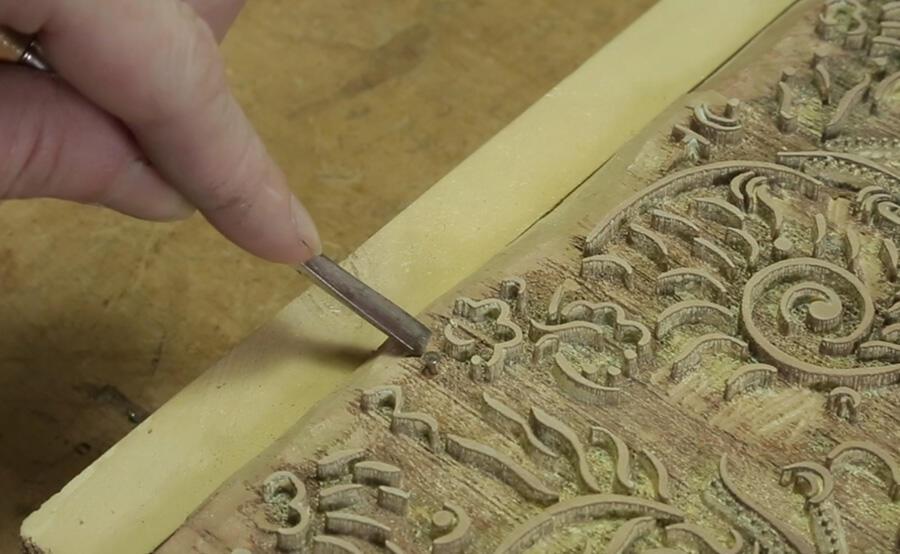A key part of Opening up the Soane was the recreation of the original wallpaper for the private apartments to match the pattern revealed by the uncovering of a large area of original wallpaper which provided a template for the pattern.
Beginning the project Back to top
Following advice from English Heritage and other specialists the commission to create the new paper was awarded to Adelphi Paper Hangings in Sharon Springs, New York - amongst the few companies left in the world able to produce block printed wallpaper of the required quality, by hand.
Before beginning work, Steve Larson of Adelphi spent time in London carefully creating colour samples (in watercolour on paper) exactly matching the bright original colours of Soane’s paper, preserved in a small sample in the Cowtan Order Book at the Victoria and Albert Museum. These samples would be used to exactly reproduce the original colours when making the new paper.
Creating the paper Back to top
The new wallpaper needed to be printed onto Elephant-sized sheets of paper (as described in the archive bills). Griffen Paper Mill at Roscommon, Ireland, produced the traditional hand-made paper, pressed in a specially made Elephant sized mould. It had to be produced in time for transport before the coming of Winter risked the factory (in an Old Post Office) being cut off by snow! Sadly this fantastic small specialist Mill, a Royal Warrant holder, has since closed. Once in America, the individual sheets were glued together to create the rolls of paper onto which the wallpaper was printed.
Creating the printing blocks Back to top
The next stage was to create the blocks required to print the pattern – one block for each of the three colours – dark orange, light yellow and cream - on a maroon background. Tracings on acetate were taken from a full-size photograph of the original wallpaper – each tracing copying the elements printed in just one of the colours. The tracings then had to be overlaid to make sure that they all lined up precisely. In an additional technical challenge, the tracings had to very slightly enlarge the pattern to allow for shrinkage of the paper as it dried after printing (to ensure it would be exactly the same size as the original). The three acetate transparencies were then used as templates to laser-cut the blocks. The hand-tracing ensured a tiny degree of variation in the lines to preserve the free-hand quality of the hand-carved blocks that were used in the early 19th century.
Creating the paint Back to top
The paper rolls were then painted with the background maroon colour in preparation for printing. The film follows Steve’s careful blending of ground pigment in different quantities: 56 grams iron red; 46g yellow ochre (yellow iron oxide) and 7g of carbon black, before mixing the colours with a paint base and painting them onto test strips, adding tiny amounts of black to reach just the right match for the original colours matched at the V&A. Once this base colour has been applied the paper is hung up to dry: it is then ready for printing.
Printing Back to top
The printing process begins with the loading of paint onto the first block, which is attached to the hand-operated press. The block is lowered into a felt-lined tray primed with enough paint to load the block evenly but not enough to risk it dripping. The block is then lifted, lowered on to the paper and pressed with a weight to ensure even printing. Each block has metal pins at the 4 corners of the pattern. These press into the paper, leaving pin holes enabling the pattern to be lined up precisely: as the next block is lowered onto the paper its pins fit into the holes left by the first block. The printing process requires precision, concentration and a lot of experience and patience to gradually build up the full pattern of finished repeats along each roll of paper.
The arrival of the rolls printed so carefully half-way across the world, at Lincoln’s Inn Fields and the hanging of the paper by Mark Sandiford, was one of the highlights of the project. The result is a triumph, especially where the new paper has been carefully pieced in alongside the original paper on one wall, enabling visitors to fully appreciate its history and context.










